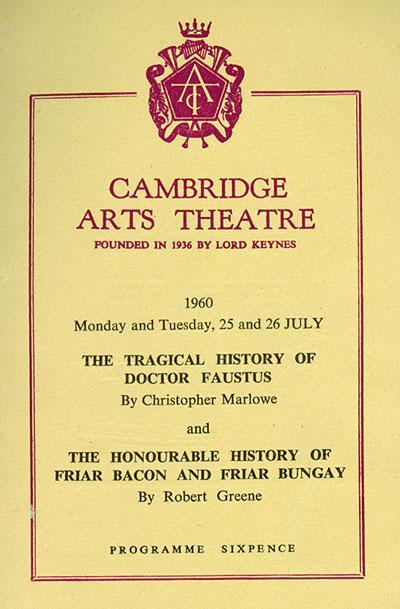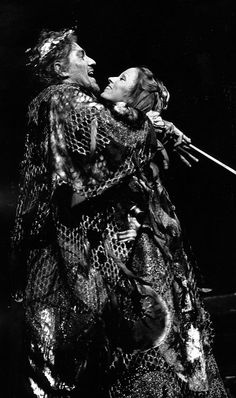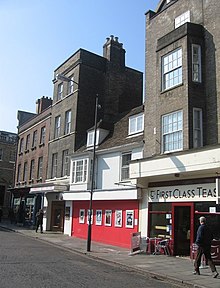ケインズとケンブリッジ芸術劇場 単行本(ソフトカバー) – 2008/8/2
中矢 俊博 (著)
98:
1934年備忘録?
私は、あらゆる近代的な舞台装置を備えた、こぢんま
りとした素敵な劇場が、文学·音楽,美術などと複雑に
関係している演劇芸術を理解するのに必要である、と確
信しています。これは経験科学にとって、実験室が必要
なようにです。
一七世紀の初めに開学した大学(キングズ·カレッ
ジ)の最も重要な関心を呼ぶ場所に、知力や想像力とい
った内面に問い掛ける「劇場」の復興に役立ちたいとい
うのが、ケンプリッジに住んでいるわたし達のような世
代の際立った特徴なのです。わたし達のメンバーは、こ
の計画の素晴らしい点を良くご存知のことでしょう。
私は、この劇場が、ケンブリッジに学ぶために来てい
しこう
る人々の暗好や想像力を作り上げるのに、大きな役割を
果たすものと考えています。
https://en.wikipedia.org/wiki/Cambridge_Arts_Theatre ★


Our History | Cambridge Arts Theatre
https://www.cambridgeartstheatre.com/discover-more/our-historyOUR HISTORY
A thriving regional showcase, Cambridge Arts Theatre is an outstanding theatre, a beacon for the development of arts professionals and a much-loved regional and national institution, whose history is rooted in the city of Cambridge. We are the only high-quality presenting theatre within 60 miles serving the population of Cambridgeshire and the surrounding area.

Founded in 1936 by the economist and founder member of the Arts Council, John Maynard Keynes, we have helped launch the careers of theatrical luminaries such as Ian McKellen, Derek Jacobi, Emma Thompson and Stephen Fry; the last four directors of the National Theatre – Peter Hall, Trevor Nunn, Richard Eyre and Nicholas Hytner – all directed on our stage at the start of their careers, and we have played host to a dazzling variety of cultural milestones, from Margot Fonteyn dancing her first Swan Lake to Harold Pinter's premiere of The Birthday Party.

Today we are the venue of choice for all scale-appropriate drama, dance and opera in both the subsidised and commercial sectors, building strong and mutually beneficial relationships with the cream of the country’s touring producers and bringing productions to the region that diversify and enrich the city’s cultural offering.
From world premieres such as Mike Leigh’s Grief, Howard Brenton’s Anne Boleyn and Mike Bartlett’s Earthquakes in London to long-running classics such as An Inspector Calls, The Woman in Black and The 39 Steps, we have built excellent relationships with the UK's leading touring companies. Established companies such as The National Theatre, Cheek by Jowl and Shakespeare’s Globe, alongside those producing bold, innovative and invigorating new work such as Kneehigh, Lyric Hammersmith and Ireland’s Abbey Theatre, help put the Arts Theatre and Cambridge firmly on the cultural map as the prime destination for touring theatre.
In summer 2013 the Theatre’s supporters invested £1.5m in the redevelopment of the Front of House spaces and significant building work transformed our existing foyer areas and provided improved bar facilities. The Theatre can only survive if we earn money from selling drinks, programmes and ice creams. Every penny we make goes to support the work of the Theatre.
Cambridge Arts Theatre: A Timeline
Cambridge Arts Theatre: A Timeline
Bibliography: ‘Cambridge Arts Theatre. Celebrating Sixty Years’ edited by Rupert Christiansen; Granta Editions, 1996
★
Cambridge Arts Theatre is a 666-seat theatre on Peas Hill and St Edward's Passage in central Cambridge, England.[1] The theatre presents a varied mix of drama, dance, opera and pantomime. It attracts some of the highest-quality touring productions in the country, as well as many shows direct from, or prior to, seasons in the West End. Its annual Christmas pantomime is an established tradition in the city. From 1969 to 1985, the theatre was also home to the Cambridge Theatre Company, a renowned national touring company. The Cambridge Arts Theatre was founded in 1936 by the famous Cambridge economist and statesman John Maynard Keynes.
 | |
| Address | 6 St Edward's Passage Cambridge, England United Kingdom |
|---|---|
| Coordinates | 52.204300°N 0.118424°E |
| Capacity | 666 |
| Opened | 1 February 1936 |
| Website | |
| cambridgeartstheatre | |
The Cambridge Arts Theatre has also been home to performances of Cambridge University's Marlowe Society, and it provides a venue for the university's triennial Cambridge Greek Play performed in Ancient Greek. In previous years it also housed performances by Footlights, the Cambridge University Gilbert & SullivanSociety and the Cambridge University Musical Theatre Society.
Contents
HistoryEdit
| Learn more |
Side entrance on St Edward's Passage
The Cambridge Arts Theatre opened on 3 February 1936 with a gala performance by the Vic-Wells Ballet, featuring among others Robert Helpmann, Margot Fonteyn and Frederick Ashton. The theatre was paid for by a share scheme supervised by its founder John Maynard Keynes, at a cost of £15,000. When only £2,300 was raised by subscription of the town, Dr Keynes underwrote the rest himself. Intending to represent both "town and gown", the Trust included the Provost of King's College, its English and Music professors, the mayor and the deputy mayor. Keynes' wife, the renowned dancer Lydia Lopokova was also key to the theatre's foundation.
Dadie Rylands went on to be the theatre's chairman from 1946 to 1982. The theatre hosted the world première of Harold Pinter's The Birthday Party in 1958. Other premières have included Secrets Every Smart Traveler Should Know and Someone Like You. In September 2008 it hosted the world premiere of a new stage adaptation of Tracy Chevalier's play Girl with a Pearl Earring, prior to a transfer to the West End. Artists to have appeared here include Ian McKellen (in a Marlowe Society production of Cymbeline), Derek Jacobi, and, more recently Susan Hampshire, Nigel Havers, Simon Callow, and Warren Mitchell.
Cambridge Theatre CompanyEdit
The Cambridge Arts Theatre was home to the Cambridge Theatre Company (established in 1969), which became one of the most respected and influential touring companies in the UK. Formed as a sister company to Toby Robertson's Prospect Theatre Company and Ian McKellen's Actors' Company (presented as part of CTC),[2] the Cambridge Theatre Company enjoyed enormous loyalty in its home town, and many excellent emerging actors were featured in its wide repertoire.
Under Jonathan Lynn (1976–1981) many of the company's productions transferred to the West End. Lynn, a 1963 Cambridge graduate along with John Cleese and others in the Footlights, used his many contacts to build up a successful repertoire of quality drama. He commissioned plays from Frederic Raphael (After the Greek) and Royce Ryton (The Unvarnished Truth with Tim Brooke Taylor and Graeme Garden), and his production of Songbook, a spoof musical by Julian More and Monty Norman, transferred to London in 1978.
Like the Prospect Theatre Company and the Actors' Company, CTC initially operated a repertory system of a company of around 14 actors. For example, the 1974 six-play season featured Zoë Wanamaker, Oliver Ford Davies, Roger Rees and Ian Charleson. Sheila Hancock was a regular under Lynn, becoming Associate Director. Maureen Lipman starred in her husband Jack Rosenthal's play Smash! based on the ill-fated West End musical Bar Mitzvah Boy, itself based on the smash hit 1976 television play of the same name in which Lynn and Lipman had featured.
During the 1970s and early 1980s a primary function of the Cambridge Theatre Company, along with the Oxford Playhouse Company, was to provide middle-scale theatres such as in Harlow, Swindon, Darlington, Mold, Southampton, Croydon, Peterborough, Cardiff, and Stirling with good quality touring drama. The company's Arts Council of Great Britain grant was dependent on this.[3]
The directors of the company were Richard Cottrell (1969–1975), Robert Lang (1975–1976), Jonathan Lynn (1976–1981), Bill Pryde (1981–1988), Robin Midgley (1988–1991), and Mike Alfreds (1991–1999). The company's headquarters were moved to London and its name was changed to "Method and Madness" in 1995.[4][5] In 1999 the company dissolved in the face of declining interest in quality drama in the provinces.[6]
NotesEdit
- ^ "Contact us" Archived 8 August 2016 at the Wayback Machine, Cambridge Arts Theatre.
- ^ The Actors' Company. McKellen.com. Retrieved 23 July 2016. Archived 3 May 2013 at the Wayback Machine
- ^ Andrew Blackwood – Obituary[dead link]
- ^ Mike Alfreds
- ^ "The Laughing Audience: Oxford Playhouse Company: Anvil Productions". Archived from the original on 10 June 2010. Retrieved 17 June 2010.
- ^ Christiansen, Rupert. Cambridge Arts Theatre: Celebrating Sixty Years. Granta Editions, 1996. p. 78.
External linksEdit
| Wikimedia Commons has media related to Cambridge Arts Theatre. |
John Maynard Keynes: the economist as saviour 1920-1937 - 528 ページ
返信削除https://books.google.co.jp › books
7 From this time, too, he started making substantial donations to charities, settling annuities on Bunny Garnett, Duncan Grant and younger ... Kennedy had also submitted plans, costing £42,000, for a new theatre and hostel for King's College students at Cambridge, on a site ... Keynes submitted a memorandum on 25 July 1934, in which he undertook to accept financial responsibility for building and ...
Robert Jacob Alexander Skidelsky - 1995 - スニペット表示 - 他の版
Cambridge Arts Theatre: Celebrating Sixty Years - 15 ページ
https://books.google.co.jp › books
Keynes broke the deadlock in a memorandum dated 25 July 1934 in which he undertook to form a private company to build and run it on a long lease from the College . His new scheme ' would leave us with a series of buildings from No . 7 ...
Rupert Christiansen - 1996 - スニペット表示